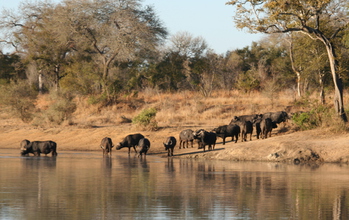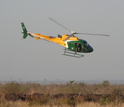Hola amigos; A VUELO DE UN QUINDE EL BLOG., hemos recibido información de la Fundación Nacional de Ciencia de Los Estados Unidos sobre las enfermedades parasitarias intestinales de los animales que sobreviven ; Gusanos parásitos, que infectan a millones de personas y otros animales de todo el mundo, influyen en cómo el sistema inmune responde a enfermedades como el VIH y la tuberculosis.
En un nuevo estudio de búfalos africanos, de la Universidad de Georgia (UGA) ecólogo Vanessa Ezenwa ha encontrado que el tratamiento antiparasitario drásticamente mejora las posibilidades de un animal de sobrevivir a la tuberculosis bovina - pero con la consecuencia de aumentar la propagación de la tuberculosis
En un nuevo estudio de búfalos africanos, de la Universidad de Georgia (UGA) ecólogo Vanessa Ezenwa ha encontrado que el tratamiento antiparasitario drásticamente mejora las posibilidades de un animal de sobrevivir a la tuberculosis bovina - pero con la consecuencia de aumentar la propagación de la tuberculosis
en la población.....
"Las intervenciones de salud a veces pueden tener resultados inesperados y no deseados", dijo Sam Scheiner, la Fundación Nacional de Ciencia (NSF) director de Ecología y Evolución del programa de Enfermedades Infecciosas (EEID), que financió la investigación. NSF, los Institutos Nacionales de Salud y el Departamento de Agricultura de Estados Unidos apoyan el programa EEID.
"Si se piensa en los seres humanos en este contexto, esto es lo que nos gustaría hacer - para averiguar cómo ayudar a las personas que se infectan por algo vivo más tiempo y ser menos enfermos", dijo Ezenwa. "Pero aquí nos encontramos con que hacer exactamente eso puede tener consecuencias imprevistas."
 Credit and Larger Version |
http://www.nsf.gov/news/news_summ.jsp?cntn_id=133775&WT.mc_id=USNSF_51&WT.mc_ev=click
Parasitic worms, which infect millions of people and other animals around the world, influence how the immune system responds to diseases like HIV and tuberculosis.
In a new study of African buffalo, University of Georgia (UGA) ecologist Vanessa Ezenwa has found that de-worming drastically improves an animal's chances of surviving bovine tuberculosis--but with the consequence of increasing the spread of TB in the population.
"Health interventions can sometimes have unexpected and unwelcome outcomes," said Sam Scheiner, National Science Foundation (NSF) director for the Ecology and Evolution of Infectious Diseases (EEID) program, which funded the research. NSF, the National Institutes of Health and the U.S. Department of Agriculture support the EEID program.
"By examining such outcomes, we can design better intervention strategies for infectious diseases."
The findings, published this week in the journal Science, have implications for human health.
"If you think about humans in this context, this is what we'd like to do--to figure out how to help people who get infected by something live longer and be less sick," Ezenwa said. "But here we found that doing exactly that can have unanticipated consequences."
Testing buffalo for parasitic worms
Ezenwa and co-author Anna Jolles of Oregon State University conducted the research in South Africa's Kruger National Park.
In 2008, with the assistance of the park's Veterinary Wildlife Services Department, they captured 216 African buffalo and tested them for parasitic worms, known as helminths, and for bovine TB.
Half the buffalo received treatment for helminths; the rest were left untreated as a control group.
For the next four years, the scientists recaptured and retested each buffalo approximately once every six months.
They found that animals treated for worms were nine times more likely to survive TB infections than untreated animals; with the worms gone, their immune systems were able to mount a stronger defense against TB.
According to Ezenwa, this finding confirmed predictions about the effects of worms on the immune system based on an earlier study of TB and helminth infections in African buffalo.
"We'd done a one-off, short-term experiment to see if we could replicate, in this wild animal, the immunological results seen in laboratory experiments treating helminths in mice," she said. "That led to this larger experiment in a much bigger population over a longer time."
Treatment not always a plus
Ezenwa said that the previous work also suggested that treatment would reduce the rate at which individuals acquire TB infection and therefore the TB transmission rate.
"We expected it would be a net positive for the individual and for the population," she said. "But in fact when you carry out an experiment at this larger scale, in a real population, you see it's not all positive outcomes."
The improved survival rate allows infected buffalo to continue to spread TB within the herd, Ezenwa said.
Since they still get infected at the same rate there is an unexpected negative result for the population as a whole.
"Because coinfection is such a complicated area, laboratory studies are really essential in telling us about the detailed mechanisms of how immunological interactions work," she said.
"But we will never understand the real implications if all the work concentrates in the lab."
Need to look at similar animals to humans
Ezenwa said that in order to address human infectious disease problems, researchers need to also look at coinfection in populations that bear more similarity to humans.
"African buffalo are long-lived, they're in the wild in social groups, they're genetically variable--that's a little bit closer to people than laboratory mice, which have the same genetic background and live under artificial conditions," she said.
And understanding bovine TB-helminth coinfection in African buffalo is particularly relevant for human health because helminths are known to influence human immune responses to TB.
"The number of human cases of bovine TB worldwide is unknown, but where it's studied, it appears to be a substantial fraction of the total," said Frederick Quinn, head of the UGA Department of Infectious Diseases in the College of Veterinary Medicine.
"It's also unknown if bovine TB bacteria transmit more efficiently than other TB bacteria, what traits this pathogen possesses that allow infection of so many different species of mammals, and what happens when the host is co-infected with parasites or HIV.
"This work is a tremendous start in answering some of the fundamental questions about this disease and how best to control it in humans and other animals."
-NSF-
Media Contacts Cheryl Dybas, NSF, (703) 292-7734, cdybas@nsf.gov
Beth Gavrilles, UGA, (706) 542-7247, bethgav@uga.edu
Beth Gavrilles, UGA, (706) 542-7247, bethgav@uga.edu
Related WebsitesNSF Special Report: Ecology and Evolution of Infectious Diseases: http://www.nsf.gov/news/special_reports/ecoinf/
NSF Ecology and Evolution of Infectious Diseases Discovery Article Series: http://www.nsf.gov/discoveries/disc_summ.jsp?cntn_id=133576&org=NSF
NSF-NIH-USDA Ecology and Evolution of Infectious Diseases Grants Awarded: http://www.nsf.gov/news/news_summ.jsp?cntn_id=132570
The National Science Foundation (NSF) is an independent federal agency that supports fundamental research and education across all fields of science and engineering. In fiscal year (FY) 2014, its budget is $7.2 billion. NSF funds reach all 50 states through grants to nearly 2,000 colleges, universities and other institutions. Each year, NSF receives about 50,000 competitive requests for funding, and makes about 11,500 new funding awards. NSF also awards about $593 million in professional and service contracts yearly.
Useful NSF Web Sites:
NSF Home Page:
http://www.nsf.gov
NSF News:
http://www.nsf.gov/news/
For the News Media:
http://www.nsf.gov/news/newsroom.jsp
Science and Engineering Statistics:
http://www.nsf.gov/statistics/
Awards Searches:
http://www.nsf.gov/awardsearch/

Buffalo herd on the move, with a young male peering at the camera.
Credit and Larger Version

Buffalo being darted from a helicopter at the beginning of the study.
Credit and Larger Version

Researchers Rob and Jo Spaan collecting samples during a routine buffalo capture.
Credit and Larger Version

A radio-collared buffalo walks off the research site scene.
Credit and Larger Version

The researchers' findings are described in the Jan. 9, 2015 issue of the journal Science.
Credit and Larger Version
The National Science Foundation (NSF)
Guillermo Gonzalo Sánchez Achutegui
ayabaca@gmail.com
ayabaca@hotmail.com
ayabaca@yahoo.com
Inscríbete en el Foro del blog y participa : A Vuelo De Un Quinde - El Foro!

No hay comentarios:
Publicar un comentario